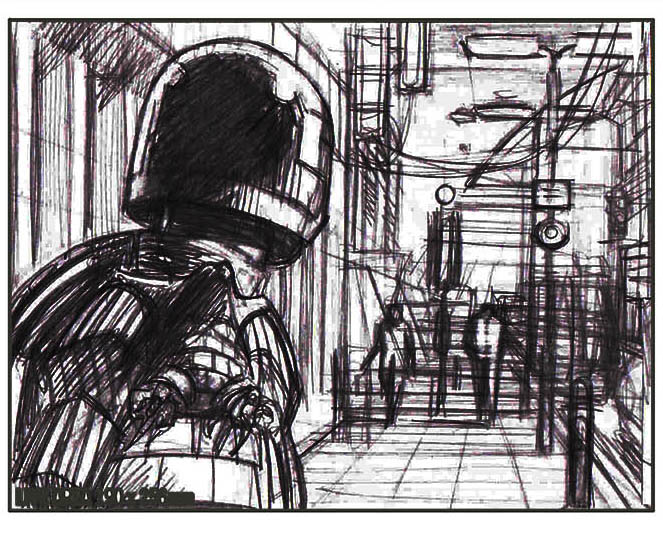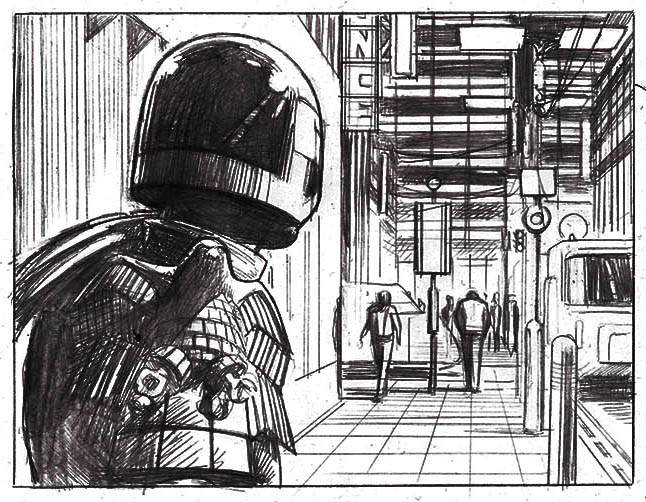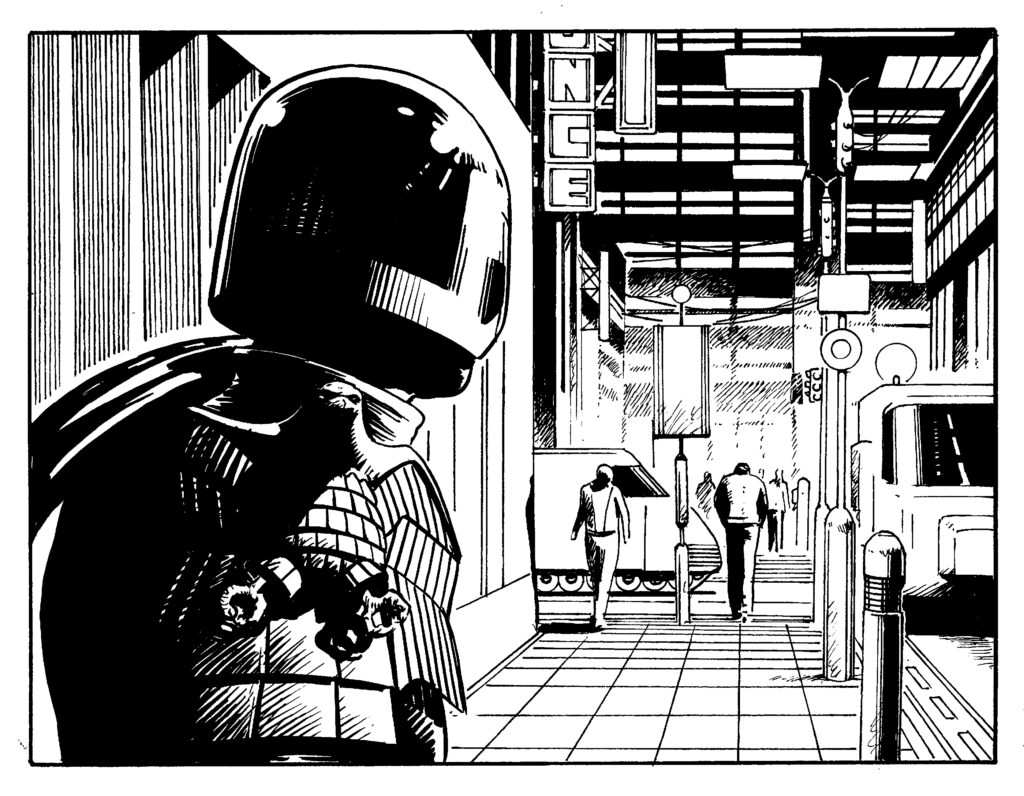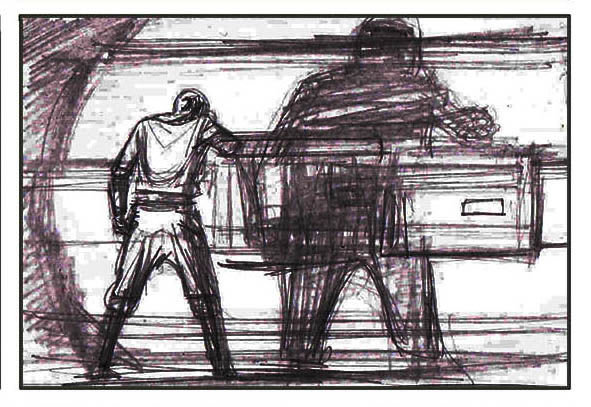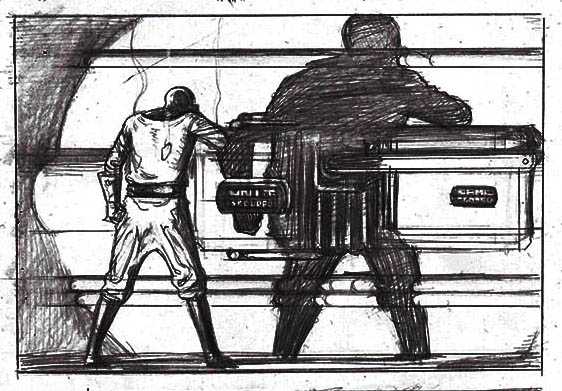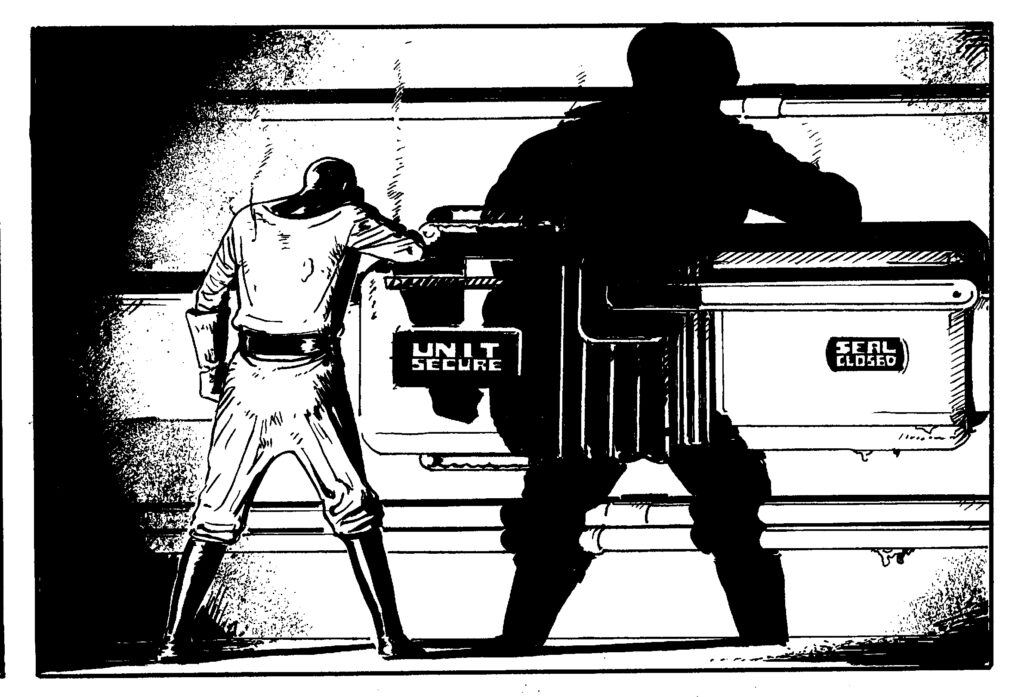INTERVIEW: Tom Foster on ‘Judge Dredd: A Penitent Man’
5th April 2021
Borag Thungg Earthlets! We’ve got a treat for you here, as we talk to art droid extraordinaire, Tom Foster, about his first multi-part Judge Dredd, A Penitent Man, written by Ken Niemand and starting in 2000 AD Prog 2225 – which is out right now!
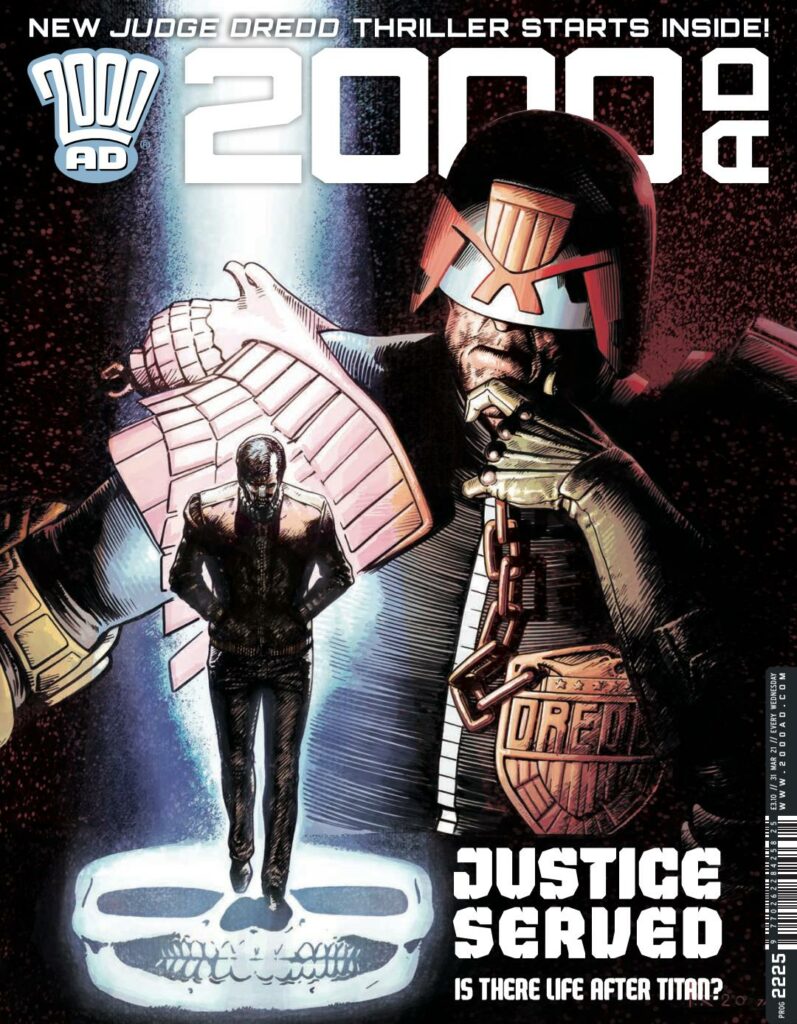
Since winning the 2013 2000 AD & Thought Bubble art competition that gave him the chance to shine in Prog 1886 with a Tharg’s Terror Tales written by Alec Worley, Tom Foster’s become a fan favourite artist in both 2000 AD and the Judge Dredd Megazine. He’s worked on Dredd, Sinister Dexter, and contributed covers, but this new multi-part Dredd, as well as co-creating (with Leah Moore and John Reppion) the brilliantly grumpy Brit-Cit Judge, Lillian Storm, in Storm Warning, have been two crowning achievements of a career that we all hope continues here at the Nerve Centre for many, many years to come!
Now… over to Tom to talk about A Penitent Man, where Dredd’s got his bionic eye fixed firmly on a newly arrived Titan inmate who’s telling him a tale of high-level corruption and murder – and he’s pointing the finger at the SJS.
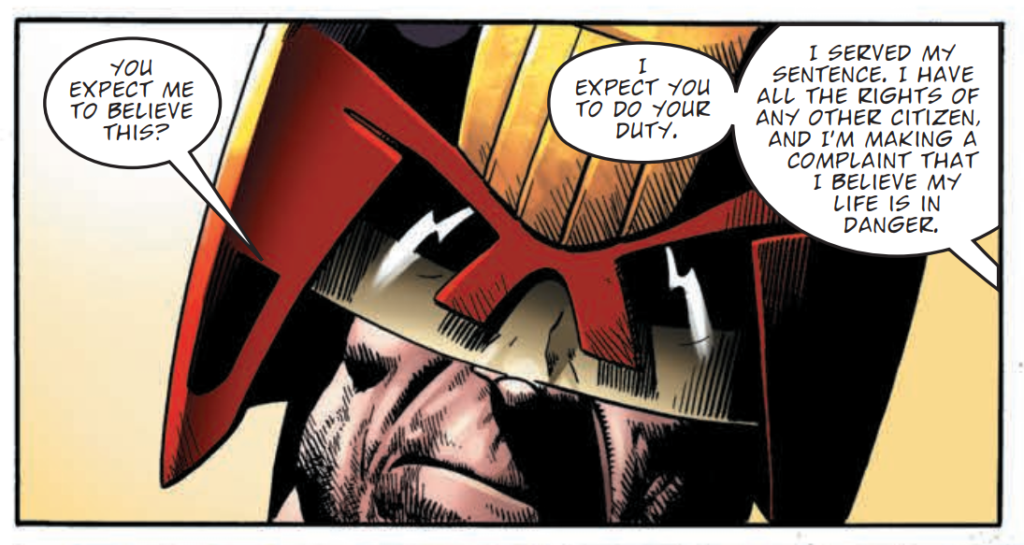
Tom, 2000 AD Prog 2225 is quite the big deal for you – another great cover by you plus your first-ever Judge Dredd multi-parter beginning.
How does that feel and do you now consider yourself ‘properly‘ a Dredd artist or does the insecurity kick in and you feel you need more Dredds under your belt before you feel comfortable describing yourself that way?
TOM FOSTER: I was just thinking about that today (it doesn’t matter what day you’re reading this, incidentally – the statement still stands) and I’m not sure. I do still feel a bit like a footnote in some Dreddcyclopedia, but I don’t really know how else to categorise myself, unless as a Dredd artist.
He’s certainly the character with whom most readers would associate me, and almost everything I’ve done for Tharg has been at least Dredd-adjacent but, until now, my Dredd work has been very sporadic. In fact, I drew more Dredd pages for this one story than I had previously in my entire time in The Nerve Centre. So this certainly feels like some kind of milestone.
How did this new series, A Penitent Man, come about?
TF: For my part, it was pretty straightforward. I got an e-mail asking if I could do it and that was about it. The first part was already written and ready to go. So it was already well past the pitch stage by the time I got my hands on it.
This multi-part Dredd we’re talking about is A Penitent Man, written by Ken Niemand. Can you tell us a little bit about the series, how many parts will it be, and what’s it all about?
TF: A Penitent Man is six parts and it’s mostly focussed on an ex-Judge who has returned from serving his time on Titan and is trying to reintegrate himself into Mega-City One, piquing the curiosity of Judge Dredd and incurring the, shall we say, ‘scrutiny’ of the SJS in the process.
There was also a lavish ballroom number at the end of the second act, but we cut it out.
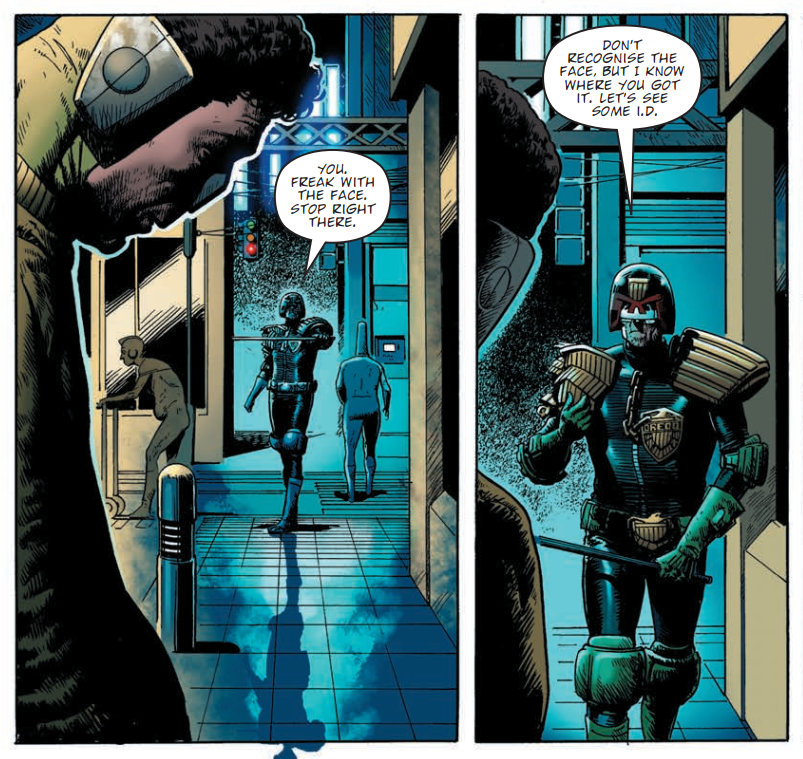
How was the collaboration with Ken Niemand for A Penitent Man?
TF: It went very well, I thought. He made no unreasonable demands of me and I did my best to preserve the tone of the writing. It’s one of those stripped-down, character studies that work quite well for someone like me who takes so long to draw things. I don’t really remember Kenneth and myself even talking all that often, which is usually a sign that the script is perfectly clear and intuitive. That’s certainly how I remember the scripts being – but, when I did need to clarify something, Mr. Niemand was very accommodating.
Having read the first couple of episodes already, it has a classic feel to it, a serious Dredd up against the SJS vibe being set-up.
TF: It’s certainly on the more sober side of the Dredd spectrum. Lots of dingy pipes and that kind of thing. Most of it is pretty focussed on the former Judge, Kyle Asher, with Dredd having to cautiously assess both Asher and the forces who would condemn him.
It’s a slow-burn though, so there’s not much more I can tell you that wouldn’t take us a bit too far into spoiler territory.
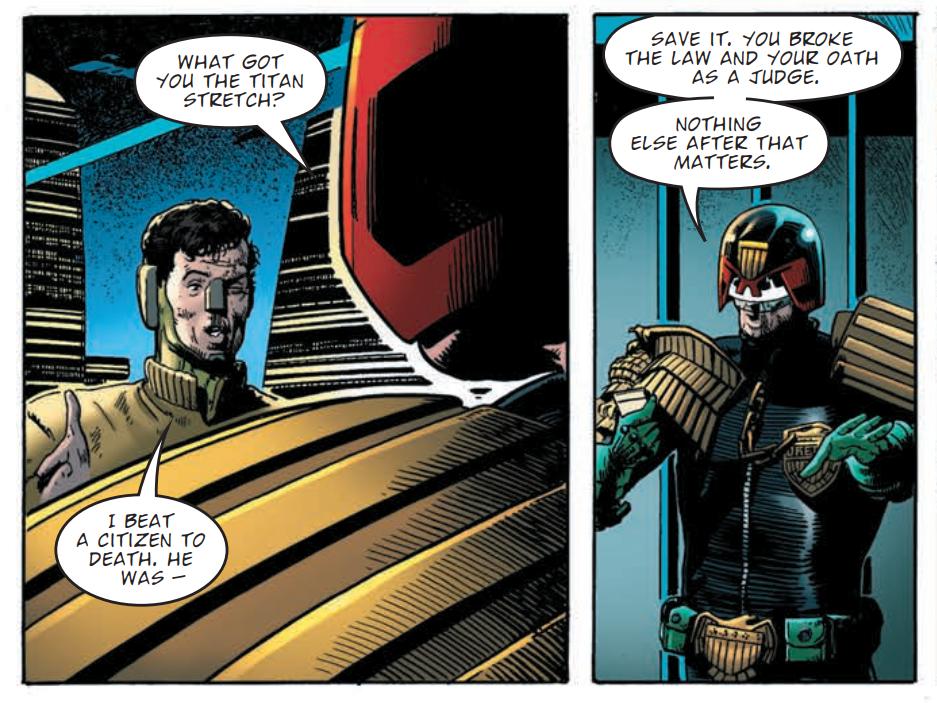
Things have certainly changed for you in the very few years since winning the 2000 AD & Thought Bubble art contest back in 2013 at the third time of asking, which we talked about a lot when you were last here at the 2000 AD site.
It’s been 8 years filled with plenty of 2000 AD work and other comics work for you, with many different strips and characters since then. Could you even have imagined all of this back in your early days?
TF: It certainly has all been very exciting, if a little daunting. I think the hardest thing for 2013 Tom to imagine would be that, within six months of completing the four-page assignment that was the competition’s prize, drawing would become a full-time job. I had absolutely no idea that the transition would be so sudden or so sustained.
I imagined that winning the competition could be a significant step closer to working in comics regularly, but that it would be more symbolic than anything. It still seems a bit strange just how neatly things worked out.
Are you now solely a professional comics artist or are you splitting your time between comics and other drawing work – storyboarding? Illustration?
TF: It’s all comics at the moment. I did a little bit of work on a film last year, but it was only a few images and only took up a couple of weeks. I’ve done some painted Commando covers too, but that’s still comics, even if it is a departure from my usual style. I do like changing things up a little every now and again, but comics art is really what I’m focussed on doing.
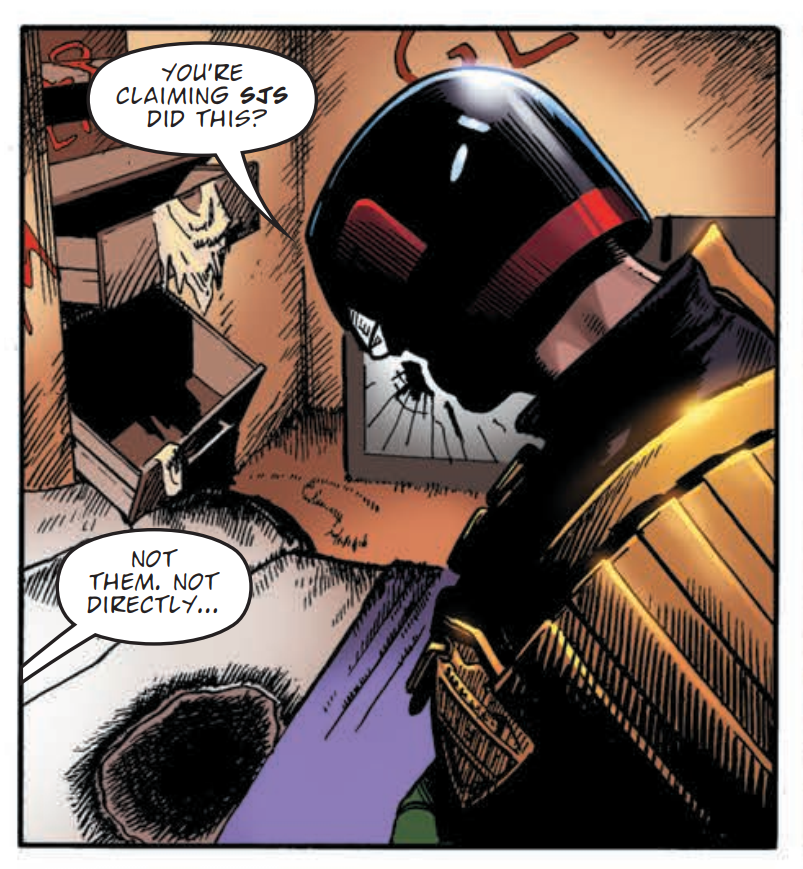
One thing you mentioned last time we chatted was the sideline in stand-up comedy. Where does that fit into all this, is it a nice release, just something completely different, or can you see it crossing over in some way further down the road career-wise?
TF: Well, as I’m, sure you can imagine, stand-up comedy has not been a particularly verdant field over the last year or so. It seemed a good time to focus on the drawing side of things. It was a shame in a way, as I’d had a lovely gig at the end of 2019 where I’d just started to expand my set, but, to be honest, I don’t think I could have continued gigging while producing this Dredd story. I was straining to keep things on schedule as it was.
I fully intend to return to stand-up when things ease up a bit, but figured I’d leave the few opportunities available during lockdown to those who are dependent on comedy for their living.
Plus you’ll have to get Tharg to give you a day-pass and undo the shackles keeping you at the drawing board!
Thinking about stand-up, preparing material, coming up with the gags, is this a sign that there’s a writer inside you desperate to get out and tell your own tales as well as drawing them?
TF: I do write quite a lot. I have a short story group with my friends where we write one story a week. But there’s a big difference between writing prose and writing scripts. I tend to lean towards the descriptive side of things, so I’m not sure how well I’d do at producing something so disciplined as a Future Shock.
Plus, if I was writing for myself, I’d constantly be thinking ‘well, that’s going to be a lot of work to draw. Maybe I should get rid of all those chandeliers’, which is no way to approach it. I’m not ruling anything out though.
Oh yes, we can’t have the script droids going easy on the art droids. We all know how much they love it when they read ‘add a huge army in the background of the scene, about 100 shock troopers, all with differently designed uniforms.’
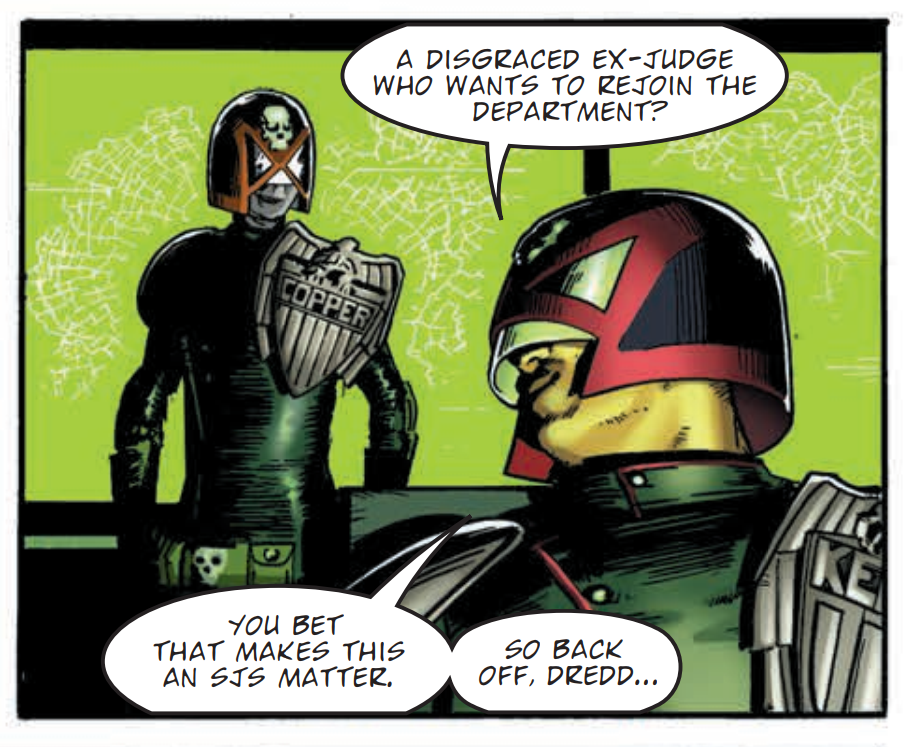
What sort of advice could you give to the young art droids desperate to make their name in the world of 2000 AD like you have?
TF: In all honesty, I would say the first priority would be drawing ability. That’s not to say it’s the most important thing, but it’s the one that takes the longest to hone to a professional level. The key elements of storytelling and composition might take years to master, but a working level of competence can be achieved relatively quickly. Figure drawing, on the other hand, is a very difficult and time-consuming practice, even after considerable study – and it’s one that you’ll likely have to undertake several times a day if you’re working in comics, so it’s worth putting in the hours.
What about your process, how are you working now and has that changed at all since the early days?
TF: I used to be very reliant on posable, 3D digital models – to the extent that I would lay out my whole page with them and then trace over the results. It was a slow, laborious and boring process and I got very tired of it.
For one thing, a lot of the fun of drawing was lost in having such a prescriptive starting point, but it was also causing my drawing ability to stagnate. I found my drawing skills improving more over one two-day comics convention (where I would be working furiously, without reference, from open to close) than in months of working over prefab digital models.
So I ditched them and started drawing everything from scratch. There was a bit of a drop-off in quality for a few weeks, but after a while the work was back to roughly the same standard, and then it started improving pretty rapidly.

From roughs… 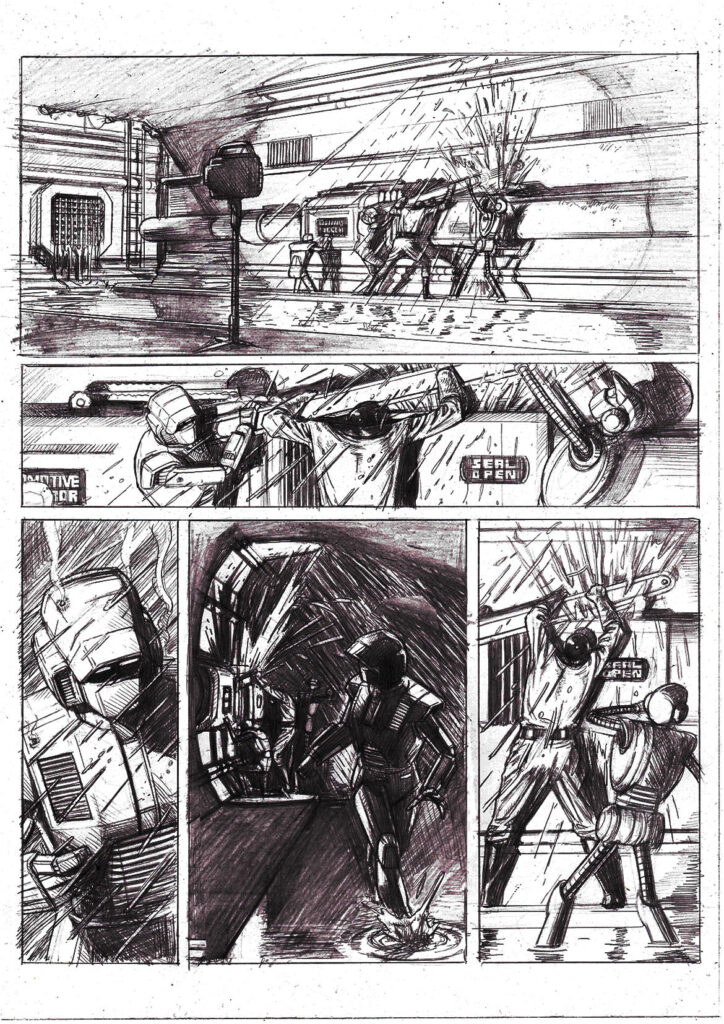
To pencils… 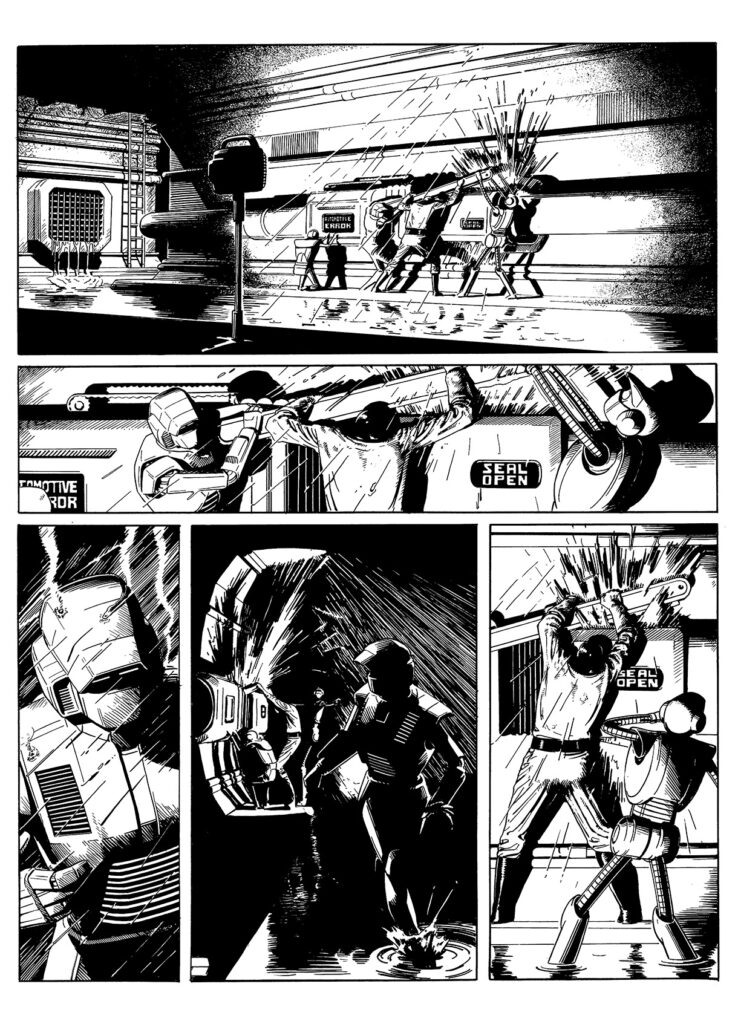
To finished inks!
Now, obviously, the comparisons to both Brian Bolland and Chris Weston have come thick and fast when anyone sees your work – it’s all in your similarly clean lines and attention to the smallest detail. Is that comparison a huge compliment or a huge millstone around your neck?
TF: It’s just a compliment, really. If it were a millstone, I could remove it by adopting a less detail-oriented approach, but since I enjoy working that way so much, I can’t ask for greater compliment than to be compared to those who do it best.
Does it ever get tiresome that all of us bloody lazy comics critics keep whipping out the Bolland comparisons?
TF: Not at all. It might if it were framed as a criticism – ‘Oh, he’s just ripping off Bolland’, that kind of thing‘ – but generally in the comics industry, a Bolland comparison is a superlative. I think it’s because his approach is so obviously not about short-cuts or oblique mannerisms. Studying his work can yield a considerable education in form and line, and the prevailing impression most people have of his work is one of ability and attention to detail, rather than style.
So, while I wouldn’t be so slavish as to try and make an identical set of drawing decisions to his, I do try and hold myself up to the same standard of draughtsmanship. I may not live up to it, but my work is always stronger for the effort.
I’ve also read about your particular love of and your influence by the work of Mark Bagley and his Spider-Man artwork?
TF: Yes, he was probably the biggest single influence on my drawing, growing up.
Would it be right to say your biggest influences are artists who manage to straddle the twin demands of delivering some element of realism in their art and yet still be able to get over that comic drama and dynamic style?
TF: That’s basically it, yeah. That mixture is very important to me. I’m not so keen on photo-realism in comics because I find it can seem a little flat and static. When you’re working in a 2D, silent, unmoving medium, I think you need to compensate for that a little. You need to enhance dimension and expression and movement, otherwise it just becomes an inferior alternative to film.
It’s like comparing black and white photography to a desaturated colour photo. The one that’s been lit and shot and exposed with black and white in mind, it can stand on its own merits, but the other is only going to have disadvantages over a more technically advanced medium.
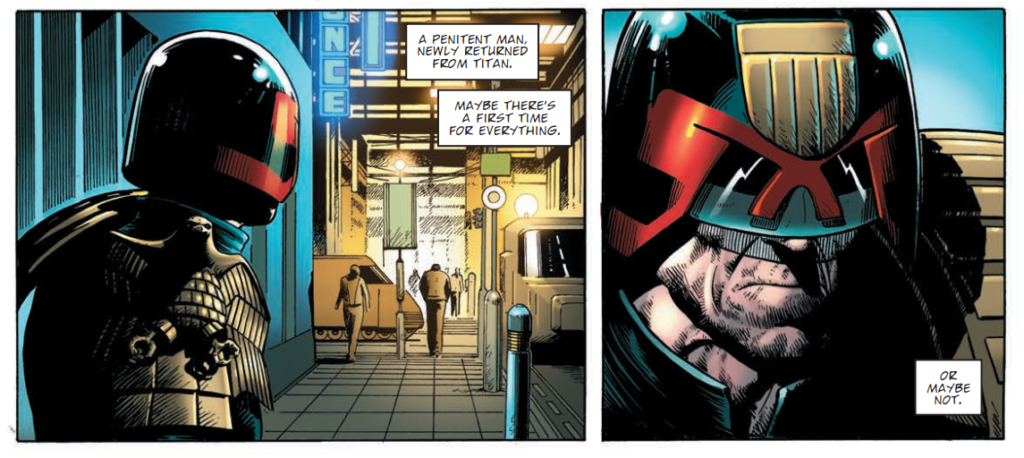
Now, a few of those old standards…What other influences would you cite, both growing up and now?
TF: In comics terms – John Romita Sr. (particularly when paired with Gil Kane), Lee Weeks, the Buscemas, Neal Adams, Alex Ross, Glenn Fabry, Micheal Lark, David Finch, Frank Quitely, Al Williamson and Ariel Olivetti would probably be the biggest direct influences, outside of Bolland, Bagley and Weston.
Outside of comics, artists like Norman Rockwell, James Bama, William Heath Robinson, Diego Velasquez, Albert Dorne, Mead Schaeffer, Joseph Wright of Derby, Dean Cornwell and Drew Struzan would be top of the pile. As well as the authors of some of the best instructional drawing books like Andrew Loomis and Gottfried Bammes.
As far as your comics history goes, what was your entry point into comics, what was it that first made you go wow? And then, perhaps the same, perhaps different, what was it that energised you and filled you with the desire to become a comics artist in the first place?
TF: Spider-Man was a big part of all that. Spider-Man and His Amazing Friends and then the 90s animated series were what got me to invest in comics as an obsession. I read the Beano and I used to get the Thunderbirds comics when they repackaged the old strips in the 90s, but mostly for the cutaways, but it was a love of Spider-Man that made me get into it seriously.
When the 90s animated series came out, there was an ad in an X-Men comic (that my dad got me when I was ill in bed one day) for a tie-in comic. I was desperate to get it because I loved the show so much (even though only one episode had aired at that point). My dad hunted high and low for it but eventually had to settle for picking up another new Spidey title instead. It was the first issue of Astonishing Spider-Man. I got every issue after that, right up until I started getting work for 2000AD. Issue two was the one where I really started to notice the artwork. That was all Mark Bagley. I would copy his drawings all the time.

Was 2000 AD part of your childhood reading or did that come later on?
TF: My dad got me Classic Judge Dredd #3 on another sick day. It was full of beautiful black and white strips from the golden age of Dredd. I read it over and over again and really liked the artwork. It’s where I first saw Bolland, Ron Smith, Cliff Robinson and Cam Kennedy. But there was only one Bolland pin-up, so it was quite a long time before I put a name to his art.
After that, I raided all my older brother’s issues of 2000 AD which, up until then, had always seemed a bit weird and inaccessible for my soft brain.
So Astonishing Spider-Man #2 and Classic Judge Dredd #3 were probably the two most important comics in determining my desire to draw comics for a living and they came out within 6 weeks of each other. Just as well I got sick so much in the Autumn of ’95, really.
Any particular dreams for you as a comic artist, any particular characters you’d like to draw – 2000 AD and further afield?
TF: Drawing Dredd was always the big one for me at 2000 AD. I suppose it is for most nascent droids. The idea of getting to draw the strip that my art idol cut his teeth on still makes me very happy, but I’m doing a Dredd-universe one-shot for this summer’s 2000 AD Sci-Fi Special that I’m really enjoying. It’s a character I’ve not drawn before, but I’ve really gotten into it. So it might be nice to do another strip with the same character. I’m not telling who it is for now though.
Outside of 2000 AD, I would like to do some superhero stuff at some point. And if I ever got the chance to do a G1 Transformers comic, that would be great too. I bloody love the original Transformers line-up. I would do a whole annual just about Trailbreaker.
Finally, you’re sometimes credited with being the art droid that either a) raised the bar on the 2000 AD From The Drawing Board videos or, b) ruined it for everyone else with your video and the combination of comedy and production values that just made other artists thinking of coming after you and doing their own fear that they’d look bad in comparison.
Would you like to apologise to your fellow artists for making them look bad at all? Or perhaps you’d like to rub it in and gloat a little? (I jest, obviously, but I seem to recall a couple of times hearing your name mentioned with how damn good and funny your video was and how it’s actually put some artists off!)
TF: I have no intention of apologising to anyone. If I can do just one thing to make all those talented bastards jealous, then my career will have been worthwhile.
Finally, finally – what’s next on the drawing board for you after A Penitent Man wraps and what can we expect to see soon, whether in 2000 AD, Judge Dred Megazine, or further afield?
TF: Well, there’s that 2000 AD Sci-Fi Special story – I’m really proud of the art on that. After that, I’m not sure. I think I might have some more Dredd coming up, but nothing’s written in stone.
I’ll tell you one thing though – I have really started to enjoy my job in the way that I always wanted to. In the first few years, the pressure to not screw it up was so strong that I had a hard time actually having any kind of fun.
Now though, while I may still totally arse it all up, I’ve finally got to the stage where I can sit and draw from morning ‘til night without tearing my hair out. So, if that continues, and I don’t go completely broke from working so slowly, I’ll be happy to be drawing just about anything.
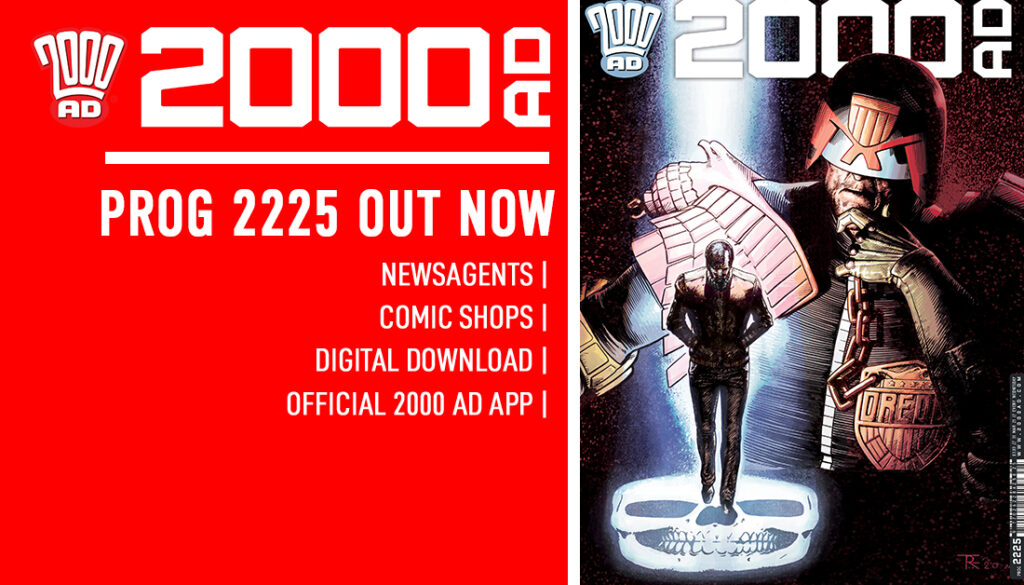
And with that, Tom checked his finances for the latest Galactic Groats from Tharg, had a little cry to himself, and retreated to the drawing board once again.
Poor, poor Tom. But you, dear reader can make him feel better. Go check out his work, grab the copies of 2000 AD with his work on Judge Dredd: A Penitent Man in it (Progs 2225 – 2230) and then tweet him to tell him how wonderful his art is. Sure, it won’t stop the crushing pain of the artists’ life, but for a few moments he’ll feel better about himself. Well, until Tharg finds out he’s been smiling again and tightens the chains attaching him to the drawing board.
You can find more from Tom on Twitter and Instagram. And check out this interview from 2018 where we talked more about the 2000 AD Thought Bubble art competition win and what it meant to Tom. If you’re looking for more of Tom’s incredible artwork, check out his art on Storm Warning, with the first Storm Warning story, The Relic, that’s collected as part of Brit-Cit Noir.
Finally, because we know the gallery images of Tom’s process might have been a touch on the small side, here’s some of that art in its full-size glory!



